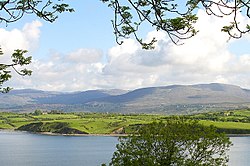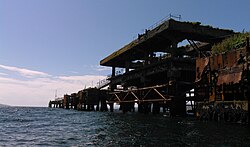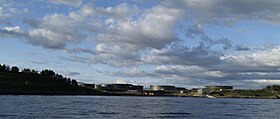Whiddy Island
| Whiddy Island Irish: Oileán Faoide | |
 Whiddy Island from Bantry Bay | |
|---|---|
| Location | |
| Location: | 51°41’22"N, 9°30’1"W |
| Grid reference: | V963496 |
| Data | |
| Population: | 20 (2011) |
Whiddy Island is an island of County Cork, lying near the head of Bantry Bay. The island is about three and a half miles long and a mile and a half wide.
Isle is of a gently-rolling glacial till, with relatively fertile soil. As late as 1880 the island had a resident population of around 450, mainly engaged in fishing and small-scale farming, but today the population has reduced to approximately 20 people.
Previously home to Whiddy Island Naval Air Station the island is noted for its oil terminal facilities – and the related Whiddy Island Disaster.
Economy and tourism
As of the 2011 census, the island has a permanent, resident population of 20 people. This increases with visitors arriving during the tourist season; many staying in self-catering accommodation in the form of restored traditional island cottages.
The island is linked to the mainland by the local ferry, Ocean Star III, with return trips several times a day.[1]
Bicycle hire is also available on the island, as is a local hackney service. Trips to and from the island and tours of the bay are available during the summer months, incorporating local history, scenery and the indigenous flora and fauna.
Walkers and anglers also travel to Whiddy Island, and the walking trails there form part of the Sheep's Head Way walking route.
There is one pub, the Bank House, which offers food and live music during the summer months.
The present-day economy is mainly fuelled by the tourism, fishing and farming industries. Due to its mild winter temperatures, it has a local reputation for producing the region's earliest potato crop.
The island is dominated by a large oil terminal which most recently has been re-purposed to store the Irish strategic oil reserve.
History
Historically, the island was strategically important as it protected Bantry Bay and the bay's deepwater anchorage. As a result, the British authorities built fortified batteries on the island in Napoleonic times, to prevent a repeat of the arrival of a French expedition of 1796 which had landed in Bantry Bay.
In the last months of First World War, Whiddy became the site of a United States naval air station. The American Navy's Air Wing established a seaplane base on the eastern end of the island; this became operational on 25 September 1918 when the first two Curtiss Model H planes arrived. These air crews patrolled shipping lanes around Fastnet Rock – close to where the RMS Lusitania had been sunk some years earlier.
One of the base's planes crashed on 22 October 1918, killing one airman, and since 2014, a memorial has stood on the island.[2]
The base had an operational radio station which received messages from as far away as America and Russia. With the Armistice of 11 November 1918, the station was no longer required and it closed in January 1919. In all, five Curtiss Model H planes were based in Whiddy during 1918: Number A1072 (a Model H-16 which crashed 22 October 1918),[3] and numbers A1078, A1084, A3466, A4047, A4048.

Economic history
A large oil terminal was constructed on Whiddy Island in the late 1960s by Gulf Oil. This was designed to accommodate the largest supertankers sailing directly from the Middle East.
On Monday, January 8, 1979, a French tanker, the Betelgeuse, was unloading a cargo of crude oil at the terminal when it exploded. The blast and subsequent fire killed 50 people. This was known as the Betelgeuse incident and is considered to be the worst maritime disaster in Irish history. The terminal, which had been operational since 1969, was never fully repaired. It was transferred to the Irish government in 1986, after which it was used to hold the Irish strategic oil reserve.
The ruins of Pilchard Palaces can also be observed close to the bank, the pilchard industry was a source of huge income for the islanders before 1900.
 |
 |
Archaeology
Archaeological remains on the island include:
- Early ecclesiastical enclosure, Kilmore
- Protestant graveyard, Kilmore
- Holy well, Kilmore
- The "Cup and Saucer", a drinking fountain made by American soldiers during First World War, Reenavanny
- Redoubts, built 1806/1807 for 100–150 men and 8–12 guns, Reenavanny
- Tower House, Reenavanny Castle of O'Sullivan Bere collapsed in storm 1920, Reenavanny
Townlands
The island's townlands are: Close, Crowangle, Gorraha, Kilmore, Reenaknock, Reenavanny and Tranaha. In Reenaknock, there is a small population of feral goats which can sometimes be seen near the road close to the oil terminal.
Outside links
| ("Wikimedia Commons" has material about Whiddy Island) |
- Whiddy Island on 'West Cork Islands'
- Whiddy Ferry
References
- ↑ "Whiddy Island Ferry". Fáilte Ireland. http://www.discoverireland.ie/Activities-Adventure/whiddy-island-ferry/61098. Retrieved 12 October 2012.
- ↑ "Whiddy honours WWI American Airman". West Cork People. http://www.westcorkpeople.ie/features/whiddy-honours-brave-wwi-american-airman/.
- ↑ "Shipwrecks of Cork Harbour". Iol.ie. http://www.iol.ie/~mkeniry/ooUnitedStatesNAS.htm. Retrieved 2013-09-09.
- Paddy O'Keeffe, the noted Bantry antiquarian's papers are deposited at the Cork City and County Archives, and there are papers relating to Whiddy, the pilchard industry, churches, land tenure and agriculture in Box 7, item 23
- Flickr – Oregon State University Special Collections & Archives – Images of Naval Air Station Whiddy Island
- Marine traffic – Whiddy Island SPM
